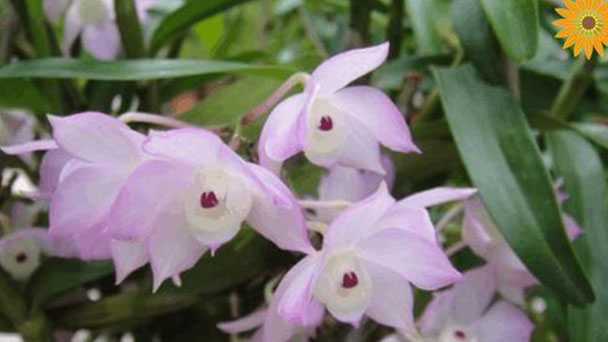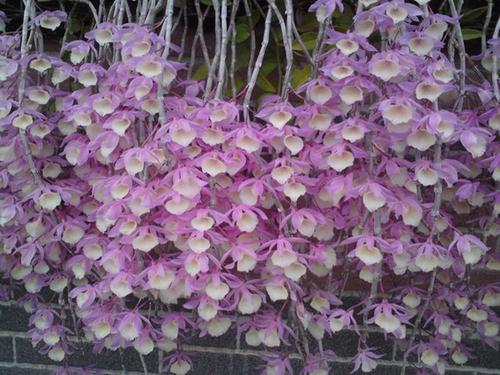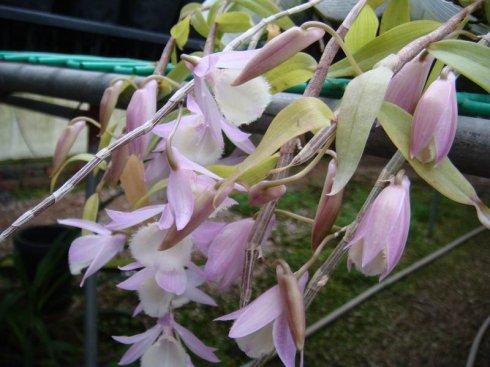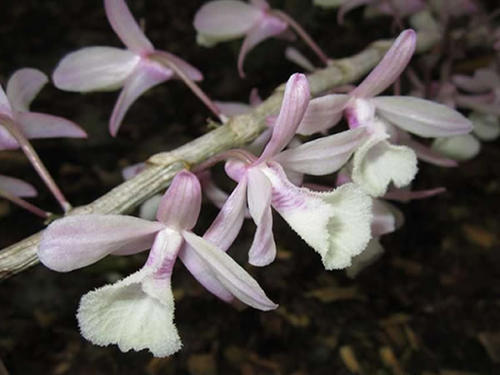Dendrobium aphyllum (hooded orchid) profile
Written by Maggie
Mar 10 2021

Dendrobium aphyllum (commonly called: hooded orchid): Stems are pendulous, flescid, fine cylindrical, unbranched, with many nodes. Leaves papery, two rows alternate on entire stem, lanceolate or ovate-lanceolate. Racemes are almost without racemes, in a bunch of 1-3 flowers, arising from decapitated or leafless old stems; Flowers are spreading, pendulous; Sepals and petals of Dendrobium aphyllum are white with lavender red or purplish-red upper part or sometimes lavender red all over; Petals are elliptic, 2.3 cm long, 9 -- 10 mm wide, apex obtuse, entire, with 5 veins; Lower sepal is broadly obovate or suborbicular. Capsule is narrowly obovate, with stalk ca. 1-1.5 cm long.
Dendrobium aphyllum picture

Morphological characteristics of Dendrobium aphyllum
Stem branches
Dendrobium aphyllum is a herbaceous plant with pendulous stems, fleshy, fine cylindrical, 30-60 (-90) cm long, 4-7 (-10) mm thick, unbranched, with many nodes; Internodes are 2-3.5 cm long.
Leaf
Leaf papery of Dendrobium aphyllum, alternate on whole stem, lanceolate or ovate-lanceolate, 6-8 cm long, 2-3 cm wide, apex acuminate, base sheathed; The leaf sheath is papery, pale white when dry, and the mouth is cup-shaped and open.
Flowers
The raceme of dendrobium aphyllum is almost without inflorescence axis, each 1-3 flowers are in a bunch, and it is issued from the old stem with leaves or leaves; Pedicle ca. is 2 -- 5 mm, base covered with 3-4 sheaths; Sheath is membranous, 2-3 mm long; Bracts are pale white, membranous, ovate, ca. 3 mm long, apex acute; Pedicels and ovaries of Dendrobium aphyllum are dark brownish greenish, 2 -- 2.5 cm long; Flowers spreading, pendulous; Sepals and petals are white with lavender red or purplish-red upper part or sometimes lavender red all over; Middle sepals are sublanceolate, 2.3 cm long, 5 -- 6 mm wide, apex subacute, with 5 veins; Lateral sepals of Dendrobium aphyllum are similar to middle sepals but equal to large, apex acute, with 5 veins, base askew; Calyx sac narrowly conical, ca. 5 mm long, terminal obtuse.
Petals
Petals of Dendrobium aphyllum elliptic, 2.3 cm long and 9 -- 10 mm wide, apex obtuse, entire, with 5 veins; Lip is wide obovate or suborbicular, about 2.5 cm wide, on both sides of the upward around the arms columnpillar form a trumpet-shaped, base with purple stripes on both sides and narrow for short claw, above the central part is light yellow, under the central part of shallow pink, margin irregular serration, densely pubescent; Stamen of Dendrobium aphyllum is white, with red stripes on front and both sides, ca. 3 mm long; Caps are white, nearly conical, tip slightly concave, densely covered fine papillate hairs, front edge wide concave.
The fruit
The capsule of Dendrobium aphyllum is narrowly obovate, ca. 4 cm long, 1.2 cm thick, with a stalk ca. 1-1.5 cm long.
The ecological habits of Dendrobium aphyllum
Dendrobium aphyllum is a kind of like cool perennial herbaceous plants, in the warm, wet, at more than 1000 mm annual rainfall, shade and light of the environment, the average temperature in January 8 ℃ higher than the growth in subtropical mountains for beautiful, suitable growth temperature of 15 to 28 degrees, is suitable for the growth of air humidity of 60% above, not very strict with techniques namely, wild in loose and thick bark or more trunk growth, and some also grown in the cleft. A pneumatic rooting system, the main requirements of the root permeability is good, the use of the best matrix can be ventilated air filter water, in the appropriate temperature and humidity, fast growth, survivability is very strong. Late spring and early summer each year, biennial stem on the upper section of the inflorescence, flowering from the stem base grow a new bud development into the stem, autumn and winter season into the dormant period.
How to grow and care for Dendrobium aphyllum
Choose the basin
Usually choose four walls porous plastic or ceramic flowerpot, with carbon root, peat moss, bark block, charcoal block for potting material. According to the size of the orchid seedlings, choose different specifications of the pot, but not with large potted small seedlings mouth planted above good materials must be soaked in clear water for more than 1 day before use. The pot bottom should be padded with large tiles or broken bricks, to the depth of about 1/3 of the pot bottom, and then put the orchid seedlings in the center of the pot, and put a thin bamboo pole on the side to fix the orchid seedlings, and then fill in other cultivation materials, and pay attention to the material between the roots.
Watering
At the beginning of planting, place Dendrobium aphyllum in a cool and shady place with scattered light, spray some water only to the leaf surface, and do not water to the basin. After about 10-15 days, after germination of new roots, two roots should be moved to the shade for conservation. Growing season watering to keep moderately dry between wet and dry pancake fat water. Growth flourishing period tree watering once a day, dry season and hot summer often need to spray water on the ground around the flowerpot, in order to maintain higher air humidity and pay attention to ventilation. Winter dormant period should be watered less. Later air humidity is too small to often water moisture, available sprayer in the form of spray water.
The temperature
Newly transplanted tissue culture seedlings of Dendrobium aphyllum are very sensitive to water, and lack of water will lead to slow growth, dry and low survival rate. However, too much spray will lead to waterlogging and rot root, and it is easy to cause the large-scale occurrence of soft rot disease when the temperature is high and humidity is high. Within a week after transplanting (seedlings have not yet developed new roots), the air humidity should be maintained at about 90%, a week later, the plant began to produce new roots, the air humidity can be maintained at 70%-80%. Planting the bed’s wet and dry potential is conducive to the growth of roots and buds. Avoid strong light, spring and autumn visible sunshine in the morning, winter can be placed insufficient light, other time in a bright scattering of light and ventilated place. The overwintering temperature can be kept at 8-10℃.
Fertilization
Because Dendrobium is aerial rooting, it is necessary to spray suitable foliar fertilizer as a nutrient solution to supply sufficient nutrients to the Dendrobium aphyllum and promote early root growth and bud growth. Foliar fertilizer can choose potassium nitrate, potassium dihydrogen phosphate, humic acid and so on, as well as imported ternary compound fertilizer and diluted MS medium. In general, one week after transplanting, the plant began to spray 1/1000 of potassium nitrate or potassium dihydrogen phosphate after the occurrence of new roots, 7-10 days spray once, continuous spray 3 times. Spray 3‰ ternary compound fertilizer every 10-15 days after the growth of new buds. The poor growth area should pay attention to topdressing, the first time around the Qingming Festival, with nitrogen fertilizer mixed with pig and cow dung and river mud. The second time before and after the beginning of winter with peanut drum, rapeseed cake, calcium superphosphate and other added to the river mud to mix evenly paste in the root, in addition to the root can be top dressing.
Pruning
Dendrobium aphyllum growth in the closed degree of about 60%, so often to the auxiliary trees pruning, in order to avoid too shade or insufficient closure. Every spring before the new whole, combined with the harvest of the old stem in the cluster to cut off the dead stem, and remove the sick stem, weak stem and the root of the disease, 6-8 years after planting according to the growth of the cluster grassroots to branch and multiply.

The propagation mode of Dendrobium aphyllum
Division propagation
Choose the value plant with dense growth. Take Dendrobium aphyllumt out of the pot, remove the old very cut from the base of the fasciculus stem, cutting the root system as much as possible, only cover and cut the connected very shaped parts, the root with the hand position, do not need to cut with a knife. The main plant of Dendrobium aphyllum was taken as a group, and the old roots were further cut off. The new bud is placed near the center of the basin, filled with new substrate and compacted to form a new plant.
Points bud propagation
When Dendrobium aphyllum cut in the pot for more than 3 years or there are plantlets on the top or base of the stem of Dendrobium autumnal, bud cutting can be carried out for propagation. Choose small plants with 3-4 leaves, 2-3 roots and 4-5 cm root length, cut them off from the mother plant, treat the wound with plant ash or 70% mancozeb, and plant them in the pot. Wang wanted shallow planting. Cultivation after 2 years generally can blossom into a commodity flower.
Cutting propagation
Cutting propagation can be carried out in combination with post-flowering and planting. Dendrobium aphyllum has a long, thin, fleshy stem with many knobs on which buds can grow, so it can be propagated with sticks. Choose the unflowering and full whole sowing strips, cut the strips into several segments, each segment with 2-3 segments, and coat the wound with plant ash or 70% mancozeb to treat the wound. Insert the stalks, section by section, into a mixture of moss and peat, half exposed, in a semi-shady, damp place. Do not need to water 1 week after insertion, and then spray frequently to moisturize and shade appropriately. After 1 to 2 months, new shoots will grow in the nodes, and 2 to 3 small roots will grow under the new buds to form new plants. Connect the new plants to the old stem and put them in the pot. Cultivate them for 2-3 years and they can blossom.
Prevention and control of diseases and pests
Disease control
Black rot
When the disease occurs, dark brown spots appear on the young Dendrobium aphyllum leaves, and yellow spots appear around the spots, which gradually spread to the leaves. In severe cases, black spots are connected to each other on the leaves, and finally wither and fall off. Prevention and control method: use 1:1:150 Bordeaux solution or Dolin 1000 times solution to prevent and control its development.
Anthrax
Hazardous leaves and stems, damaged leaves appear brown or black spots, 1-5 months have occurred. Prevention and treatment methods: spray with 50% carbendazim 1000 times solution or 50% methyl tobuzine 1000 times solution 2-3 times.
Coal sludge disease
When the disease occurs, the entire leaf surface of the Dendrobium aphyllum is covered with a layer of soot-black powder, which seriously affects the photosynthesis of the leaves and causes plant under development. The main period of the disease is from March to May. Prevention and treatment methods: use 50% carbendazim 1000 times liquid or 40% dimethoate emulsion 1500 times liquid spray once or twice.
Pest control
Mr Dong pest
This pest parasitic in Dendrobium aphyllum plant leaf edge or the back of the leaf, absorb juice, cause plant leaves wither, serious cause the whole plant yellow death. At the same time, it can also cause coal contamination. Prevention and control methods: this pest in late May is the peak incubation period, with 40% dieguo emulsion 1000 times liquid or 1-3 degree of sulfur mixture spray kill the effect is better. If the shield shell has been formed but the quantity is small, the prevention and treatment can be carried out by cutting off the leaves of the old branches and burning them or twirling them.
The snail
The pests mainly hide in the back of the leaf to eat mesophyll or bite the stem to harm the petals. This insect pest can occur many times in a year, once the occurrence, great harm, often can be in a night to eat the whole plant beyond recognition. Prevention and control methods: use bran to mix trichlorfon and spread it in the place where the pests often move to trap and kill with poison bait; Spray trichlorfon, fenpropathrin and other pesticides in the cultivation bed and surrounding environment, and also remove quicklime and saturated salt water. Pay attention to the cleanliness of the cultivation place, and remove the dead branches and leaves outside the site in time.
Distribution region of Dendrobium aphyllum
Dendrobium aphyllum is distributed all over the world.
The type specimen of Dendrobium aphyllum was collected from India (Deccan Plateau).
Dendrobium aphyllum uses
Medical use
Dendrobium aphyllum whole grass: slightly bitter, cool. Clear away heat and detoxify. For cough, sore throat, dry mouth and tongue, infantile convulsion, food poisoning, burning and scalding.
Ornamental value
Dendrobium aphyllum has a very high ornamental value. Its flower appearance is elegant, exquisite and lovely, and its color is bright and its smell is fragrant. Dendrobium aphyllum is regarded as one of the "four ornamental foreign flowers". In addition, flowers cut 2-3 days do not wither, exuberant vitality makes a person admire.

Latest Updated
- Benefits of Bugleweed - 7 Science-backed Health Benefits
- Bugleweed Dangers & Side Effects - Is It Poisonous?
- How to Plant Evergreen Trees - What You Should Know
- When to Plant Evergreens - Grow Guide for Evergreen Trees
- 12 Wonderful Evergreen Shrubs for Your Garden
- 12 Popular Evergreen Plants with Pictures for Beginners
- When And How To Prune A Lilac Bush Like a Pro
- How to Grow & Care for Lilac Vine (Hardenbergia Violacea)
- Japanese Lilac Tree (Syringa Reticulata) Care & Propagation Guide
- Shumard Oak Pros and Cons - What to Know
Popular Articles
- Winter maintenance of Antirrhinum Majus
- How to Grow Terminalia Mantaly Tree
- How to Grow and Care for Crossostephium Chinense
- How to grow Antirrhinum Majus in spring
- Peristeria Elata (Dove Orchid) Profile: Info & Care Guide
- Underwatered Snake Plant (Sansevieria Trifasciata) - Signs And How To Fix
- How to Care for Brazilian Jasmine Plant (Mandevilla Sanderi)
- How to Grow & Care for Graptopetalum Purple Delight in Summer
- Rosa Chinensis (China Rose): Plant Growing & Care Tips
- How to Care for Baby Sun Rose (Aptenia Cordifolia)